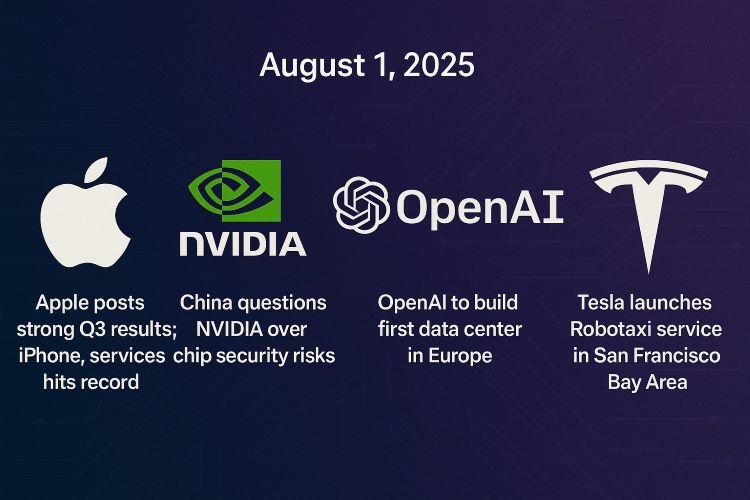AI Navigation
- articleAI Trends
- lightbulb_2AI Tips
- assistant_navigationAI Navigation
- heatHot Articles
- emergency_heat_2Hot Tips
August 1, 2025 · 24-Hour AI Update: Apple, NVIDIA, OpenAI, Robotaxi
Over the past 24 hours, the AI and tech world has seen multiple major developments: from NVIDIA being questioned over chip security concerns, to Apple posting a strong earnings report with record iPhone and services revenue, to OpenAI expanding its infrastructure in Europe, and Tesla piloting its Robotaxi service in San Francisco. These events not only reveal the strategic moves of global tech giants but also highlight the ongoing interplay between technology, regulation, and market forces.

1. NVIDIA faces chip security concerns as China’s cyberspace regulator steps in
Reports surfaced that NVIDIA’s high-performance AI chips may have serious security vulnerabilities. Previously, U.S. lawmakers had proposed that exported advanced chips include mandatory “tracking and location” functions; U.S. AI experts further disclosed that NVIDIA’s chips already have mature “tracking” and “remote shutdown” capabilities.
On July 31, 2025, China’s Cyberspace Administration formally summoned NVIDIA, demanding a full explanation regarding potential backdoors and security risks in its H20 chips, along with comprehensive technical documentation.
Commentary:
This summons could be a major blow to NVIDIA’s brand reputation, especially in the critical Chinese market. If NVIDIA cannot convincingly prove the safety of its chips, its products could face serious sales challenges in China. Chinese companies may also pivot toward “trusted and secure” suppliers, a shift that would have long-term implications for NVIDIA’s strategy.
2. Apple posts strong FY2025 Q3 earnings, services stand out
Apple reported its fiscal Q3 2025 earnings:
-
Total revenue: $94.036 billion, up 10% YoY
-
Net profit: $23.434 billion, up 9% YoY
-
Greater China revenue: $15.369 billion, up 4% YoY
-
iPhone sales: $44.58 billion, up 13%, far exceeding expectations (around $40.22B)
-
Mac revenue up 15% to $8.99 billion, iPad revenue down 8%
-
Services revenue (App Store, Apple Music, iCloud, etc.): $26.34 billion, up 13%, hitting an all-time high
Commentary:
Apple’s 13% growth in services is the biggest highlight of the quarter, underscoring the strength of its ecosystem. iPhone remains the revenue cornerstone, contributing nearly 48.7% of the quarter’s income, and ending several quarters of decline in Greater China. But compared to strong growth in the Americas and Asia-Pacific, competition in China remains intense. Apple’s gross margin rose to 47.1%, showing its strength in supply chain management and cost optimization. However, the drop in wearables and the pace of AI integration remain key challenges ahead.
3. OpenAI to build its first European data center
OpenAI announced it will build its first European data center in Norway, scheduled to go live by the end of 2025. The facility will support localized services for ChatGPT and future AI models, reducing reliance on U.S.-based cloud infrastructure.
OpenAI explained that Norway was chosen for multiple reasons: abundant renewable energy (especially hydropower) for sustainable operations, a stable political environment, and advanced digital infrastructure—all laying the foundation for long-term development.
Commentary:
This move will significantly improve the performance and user experience of ChatGPT and future models across Europe, while helping OpenAI comply with GDPR and strict local data regulations. The center is also expected to create hundreds of high-tech jobs and foster AI infrastructure growth in Norway and the broader Nordic region.
4. Tesla launches Robotaxi service in the San Francisco Bay Area
Tesla has officially launched its Robotaxi ride-hailing service in the San Francisco Bay Area. For now, vehicles still include a safety driver in the front seat to take control if needed. Once regulatory approval is secured, Tesla plans to remove the safety driver and install a safety monitor in the passenger seat—a model already tested in Austin.
Commentary:
This “safety driver → safety monitor” transition shows Tesla’s gradual, cautious approach to safety, aiming to build regulatory trust while paving the way for fully autonomous operations. Robotaxi is not just a tech showcase—it’s a cornerstone of Tesla’s software strategy. If regulators greenlight the service, Tesla’s Robotaxi network could evolve into a ride-hailing platform akin to Uber, driving recurring revenue and opening a new business model.
Conclusion
From NVIDIA’s security controversy to Apple’s strong earnings and ecosystem strength, from OpenAI’s European expansion to Tesla’s Robotaxi pilot, these stories illustrate how the AI and tech sectors are rapidly evolving:
Innovation, market expansion, regulatory pressures, and commercialization efforts are converging—reshaping the tech landscape for the next decade.
👉 For more in-depth AI analysis, visit IAISeek